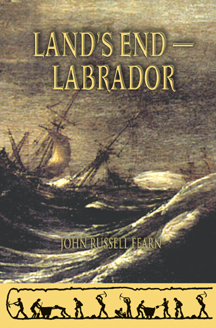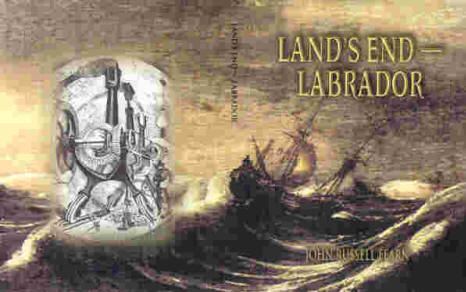


Previously unpublished. Read the Foreword below!
Quality
Trade Paperback
with French Flaps, 150 pp.
ISBN 1-55246-553-5 @ $20.00
Black Cloth
Hard Cover with French Flaps, 150 pp.
ISBN 1-55246-552-7 @ $30.00

Foreword by John Robert Colombo
The notion that there should be a Newfoundland-Labrador Tunnel has been in the
air for some years. Indeed, in April 2001, Danny Williams, Premier of
Newfoundland & Labrador, officially proposed that there should be a feasibility
study to examine the worth of the proposal.
The projected tunnel would cross the Strait of Belle Isle and
establish a "fixed link" between the small community of Yankee Point on
Newfoundland's Northern Peninsula and the lighthouse that now stands at Point
Armour in Southern Labrador. It would thus link the Great Island with the
Mainland and be a boon to transportation, communication, and tourism. It would
give a boost to the failing economies of both parts of the province.
The specifics are daunting. It would need to be an "immersed
tunnel." That means it would have to lie on top of the rocky seabed and not bore
through the seabed itself. It would require prefab construction and placement of
an encasement, seventeen kilometres in length, between sixty and ninety metres
under water. The encasement would need to shield from the turbulent waters of
the Strait of Belle Isle an electric railway train in its own tunnel capable of
conveying motor vehicles as well as high-tension hydro-electric power cables and
numerous fuel pipelines.
There is something daunting and challenging, also awesome and
terrifying, about tunnels, chunnels, "immersed tunnels," suspension bridges,
trestle bridges, viaducts, "fixed links," and so on. The terror of the tunnel,
at once claustrophobic and fate-defying, and the terror of similar engineering
marvels, would seem to defy the odds and the elements and the greed of groups of
men. Such considerations underlie the attractions of the novel Land's
End—Labrador.
John Russell Fearn (1908-1960), the author of this novel, was
an English writer of "pulp fiction." He could as easily be described as a writer
of "action fiction" or a "storyteller." He wrote stories and novels that
appeared in the pulp magazines of the day, succeeding with many of the popular
genres: mystery, crime, detection, romance, westerns, science fiction, etc. By a
quirk of fate, the byline "By John Russell Fearn" came to be known across the
Dominion of Canada. It is forever linked with the name of his most celebrated
literary creation—the Golden Amazon.
Fearn wrote more than two dozen adventure stories featuring
the Golden Amazon, or "complete novels" as they were called, and the series was
first published by the Toronto Star Weekly. They appeared between the years 1945
and 1961. A few words about that publication are in order. Now long gone, the
tabloid-sized publication was the Saturday supplement to the Toronto Star, and
it was carried by other newspapers in towns and cities across the country. At
one time the Star Weekly had a national readership estimated to be in the
neighbourhood of 900,000 readers. It reached the apogee of influence in the
1940s and 1950s. It was a great market for general articles and for popular
fiction.
The popular fiction published in its columns included the
adventures of the Golden Amazon, who was otherwise known as Violet Ray Brant,
and these stories thrilled the Star Weekly's readers, especially its young
female readers. Here was an arrestingly beautiful blonde, brilliant to the point
of genius, dedicated to saving the world of the future from the evils
perpetrated by men of ill will. The Amazon left her mark on the memories of
myriad women readers, including that of Ruth Colombo, my wife, who still recalls
the rush of excitement she felt when she first encountered the doings of the
Golden Amazon a half-century earlier.
But this foreword is not about the Golden Amazon, which will shortly be
immortalized in a series of volumes under the general title The Complete
Adventures of the Golden Amazon. When I began to research and publish in the
field of fantastic literature in Canada, I was surprised to realize that Fearn
was only one among the many noted contributors to the Star Weekly. (Others
included John Dickson Carr, P.G. Wodehouse, Erle Stanley Gardner, and Sax Rohmer,
my own favourite.) But in terms of productivity over a period of more than a
decade and a half, Fearn was probably the publication's leading contributor of
fiction. I took an interest in his science fiction and fantasy fiction and this
led me to correspond with Philip Harbottle, representative of the Fearn estate.
Philip is an English literary agent whose special interest lies in researching,
annotating, and republishing Fearn's fiction. He is the keeper of the flame.
Philip drew my attention to the fact that he had in his files
an unpublished novel of Canadian interest written by the master. It was titled
Land's End—Labrador and for some reason or other had been declined by the Star
Weekly in the 1959. Fearn died the following year, before he had a chance to
find a publisher for it. I was especially interested because of its "Canadian
content." When I expressed interest, Philip kindly sent me the typescript, which
I still have, and treasure, in its aquamarine-coloured "Anson Vistafile" folder.
When it arrived, I read it in one sitting. It tells the exciting tale of the
battle to construct an undersea tunnel to link Europe and North America. The
tunnel is to lie 12,500 feet below the surface of the Atlantic Ocean, and it is
to extend from Land's End, Cornwall, to "a point between Zoar and Hopedale on
the Labrador coast." The idea sounds absurd, but delightfully so. The characters
are ... paper thin. But the excitement they feel is apparent on every page and
in every sentence, for the stakes are high indeed. In the words of one of the
novel's characters, Douglas Lovelace, "In five years — ten at the outside — we
can link England with Canada and thereby start the unification of the British
Commonwealth of nations." Whether that is a "good thing" or a "bad thing" is
never debated.
I tried to find a trade publisher for the work, and interest
was expressed by Clyde Rose, publisher of Breakwater Books, as his company's
headquarters was in St. John's, Nfld. But all this took place in 1983, when
there was a downturn in the fortunes of Canadian publishers. (These downturns
seem to occur regularly, at least once a decade.) So Clyde Rose took a pass, as
did the other mainland (and mainstream) publishers to whom I submitted the
proposal. I felt it would make a lively novelty item, one that harkened back to
the days "when fiction was fiction." One problem was that no publishing grants
were available from the Canada Council for foreign-authored books, or for
reprints of native-authored books, or for books of wide popular rather than
narrow literary interest. After a few more rejections, I gave up trying to place
the novel, though I did continue my research into the history of Canadian pulp
writers.
A chance meeting with Dr. George A. Vanderburgh of The
Battered Silicon Dispatch Box rekindled the flame. Intrigued with the notion of
publishing a novel that had Canadian content, that was written by Fearn, and
that had never before appeared in print, George secured the rights to prepare
the editio princeps of the novel. Philip offered to contribute an
introduction to this first edition, and that wonderfully informative
introduction comes as a bonus for the reader.
I hope I will not be accused of "giving anything away" when I
say that the plan for the projected Land's End–Labrador tunnel is realized.
Fearn made sure of that! Had the editor of the Star Weekly published this novel
in 1959, it is possible — just possible — that today the notion of a
Newfoundland– Labrador Tunnel would not seem so outlandish and so unattainable.
The Premier of Newfoundland & Labrador should take note. Stranger things have
been accomplished, and science fiction novels like this one have led the way.
John Robert Colombo
Other Books by the same Author